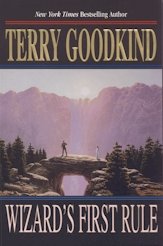
A young woodsman called Richard Cypher (hint hint) is out in the woods, pondering the murder of his father, when he sees a beautiful woman (is there any other kind?) being stalked by four men. He intervenes, and rescues her from death. From this rather quick beginning, Terry Goodkind has spun the tale of “Wizard’s First Rule.” “When writing a short story,” Chekhov supposedly said, “Finish it, then chop the first three paragraphs.” We get dropped into the action so rapidly in “Wizard’s First Rule”, that one suspects Goodkind may have known the quote.
WFR (I’m a little too lazy to be typing the whole thing every time I refer to it), is, at first blush, a groaning retelling of Tolkien. When you think about it, it has all the trappings: innocent youth going on quest to save world – a sylvan northern place, of course – from evil bad guy, aided by friends and (of course), old wizard. It’s a bildungsroman from start to finish – though finish may be the wrong word, since this book is the first one of eleven equally weighty tomes. Why me God?, I groaned as I saw the stat: can these things not be afflicted with the Multiplicate Virus? Was I gonna have to plow through millions of words in order to grasp what amounts to an introduction?
And Terry Goodkind, who published this work in 1997, doesn’t make the going easy either. After a that rather lurching beginning that drops us so disconcertingly into the main events, he tediously sets up character and world and scene in what consists of half of a 900 page novel. It’s like the journey to Rivendell took twice as long. He mixes elements of Middle Earth, the Quest, the numinous object and modern pop culture in a medieval setting in often intriguing ways. It’s quite a read.
This version of Middle Earth is a land divided into three spheres: Westland, without magic, Midland with it, and the more easterly realm of D’Hara, also with magic. The three lands are separated by a now-failing boundary which once prevented passage between them, set there by wizards long ago, but still within memory of the living. The ruler of D’Hara, an evil emperor (aren’t they all?) called Darth Vader – sorry, Darken Rahl – is taking over Midland and possesses magic greater than even that wielded by the great wizards of old. In a nutshell, it becomes Richard’s task to stop him, since Darken Rahl is bent not only on world domination, but actual world destruction. One wonders what he’ll do with the wasteland he ends up with.
WFR is a self-contained story – much to my relief – and to some extent suffers from what I term “First Novel Syndrome” – which is that suspicious effluvium one finds in some first novels: occasional loose plotting, language that doesn’t ring true, motivations and interactions and events that occur just a little too conveniently. In this instance, these matters exist and can be spotted – the sudden appearance of Scarlet is a particularly egregious (and irritating) example of the phenomenon in action – but are fortunately not always that obvious. It’s sad that a novel this ambitious and this taut needs to resort to clumsy plot devices to get our boy out of a corner Goodkind has written him into.
I can go on about the world Goodkind has created, the characters he populated it with, and the backstory and history with which he fleshes things out, even the long narrative and intricate plot: but that would be pointless. In a series of this kind the crucial questions are always the same: is the world a unique one, populating our mental landscape with new images and distinctive characters? and are the old legends of our time woven in new and spellbinding ways?
And so I must be honest: once one gets past the issues I mention, slogs on past the halfway point when all is made clear (more or less), when one finally has a good grasp of the issues, the history and the culture of the world…then things really do take off. And better yet, Goodkind clearly had his multiplicated stretch-limo of a series in mind from the beginning, since it is obvious he is setting things up for future novels (full disclosure: in researching WFR, I peeked at summaries of what comes later), and that gives this book a solid historical and cultural grounding and a richness and depth not always found in fantasy wannabees and pretenders to Tolkien’s throne. Stilted and choppy dialogue aside – too many conversations take place simply to inform the reader – the core relationships between Richard, Zed and Kahlan are solid (if straightforward), and required. And I have to admit: Goodkind enjoys springing surprises on us, he changes direction on a dime, and yet his plot makes good use of all previously supplied information – he does not cheat.
The fantasy books that stick with us are those that have a strong storyline, do not bore and have both environments and characters we care about. Martin’s Song of Ice and Fire, the worlds of Fionavar, Middle Earth, Earthsea, Discworld and Donaldson’s Land are all places that have colonized our imaginations and enriched our reading with their magic and heroic tales. Now here is the world of WFR – imperfect, intriguing, interesting and powerful. Not all will be enthused by having to read eleven books, and like Jordan’s epos The Wheel of Time, it may fail at the back stretch: but with this one work, Goodkind has created an entry that, if it avoids the pitfalls all too common inn the genre, may rise to share a table with the best of them.
I’d say that for a book I started out disliking, that’s no faint praise.